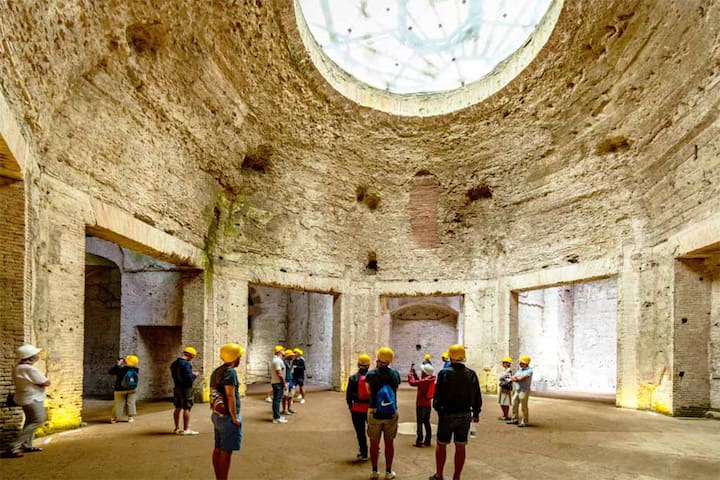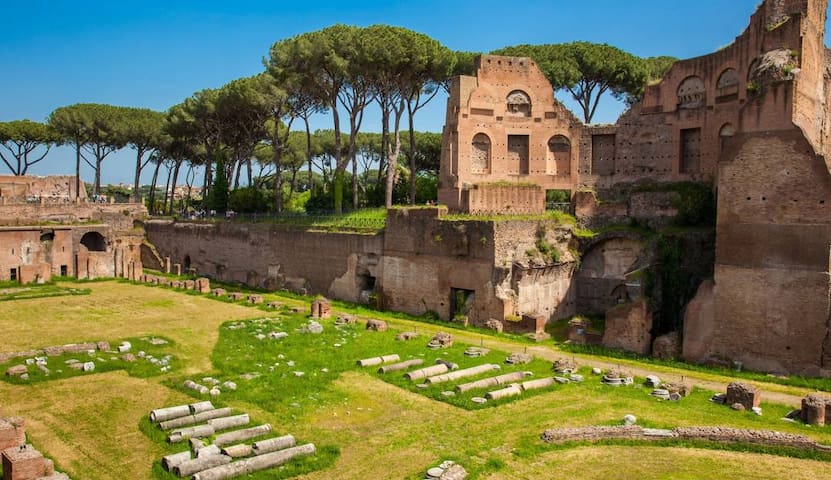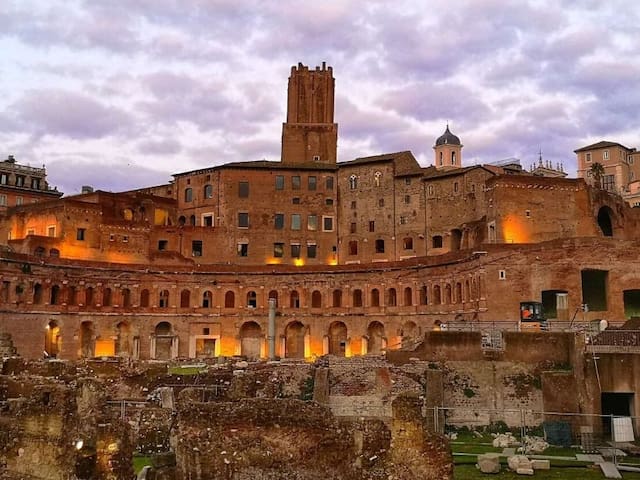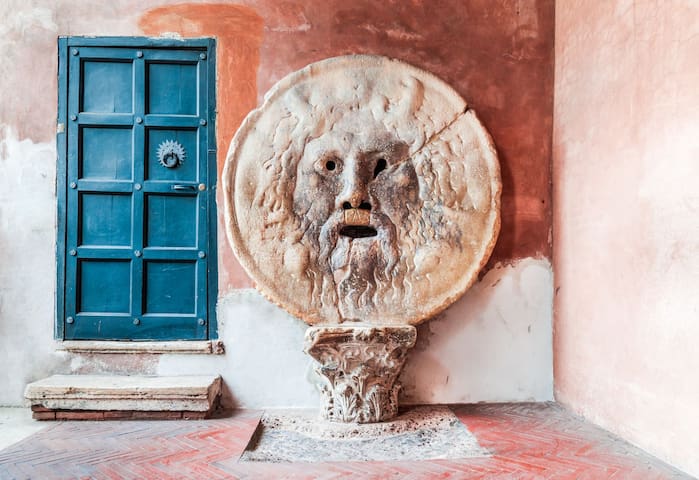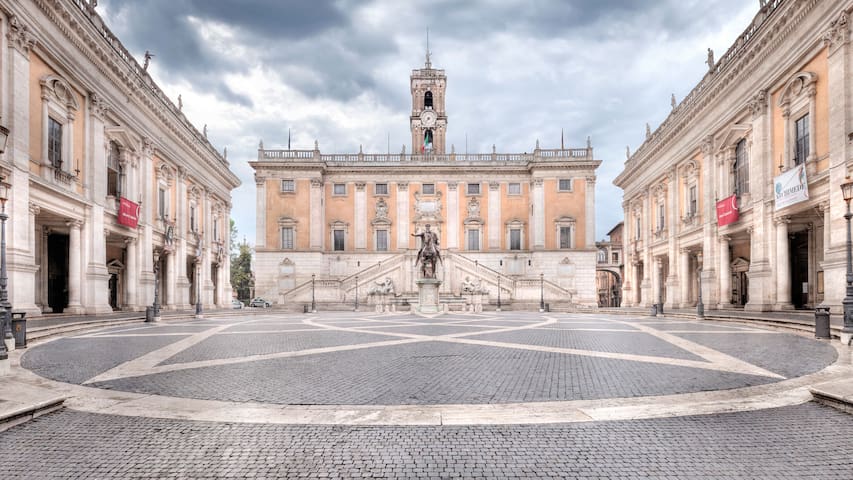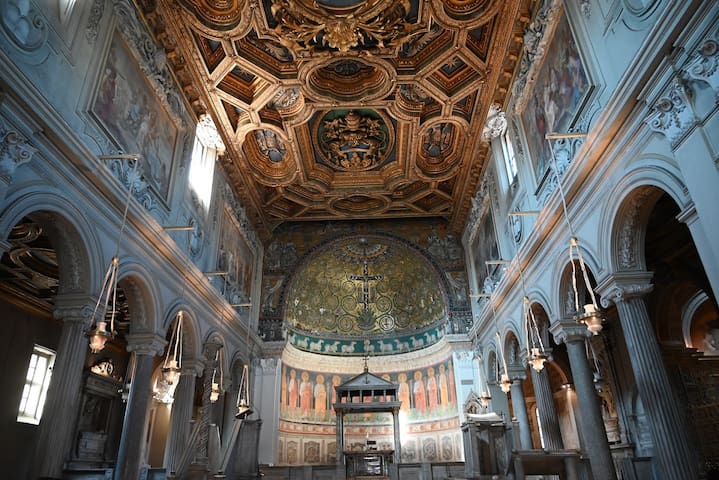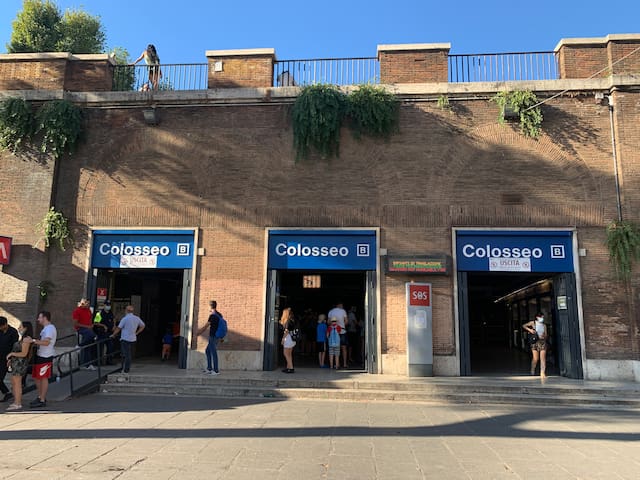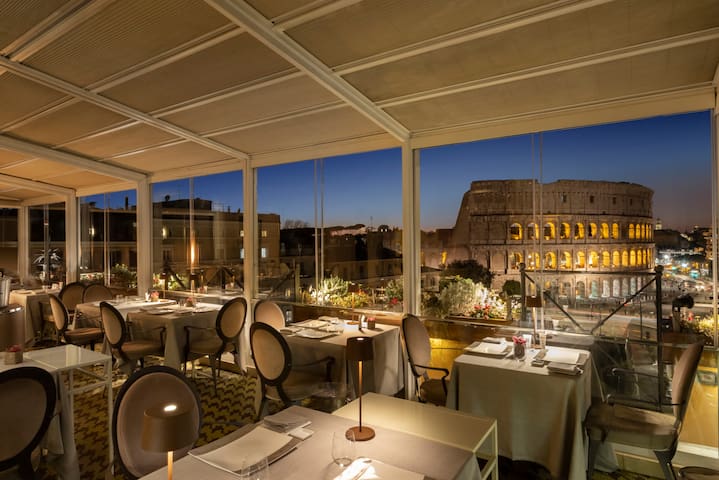Sightseeing
It may be two thousand years old but the Colosseum is still the symbol of the eternal city, every year drawing thousands of visitors, meaning long queues and an endless wait.
666 当地人推荐
罗马斗兽场
It may be two thousand years old but the Colosseum is still the symbol of the eternal city, every year drawing thousands of visitors, meaning long queues and an endless wait.
The Baths of Caracalla (Italian: Terme di Caracalla) in Rome, Italy, were the city's second largest Roman public baths, or thermae, likely built between AD 212 (or 211) and 216/217, during the reigns of emperors Septimius Severus and Caracalla. They were in operation until the 530s and then fell into disuse and ruin.
147 当地人推荐
卡拉卡拉浴场
The Baths of Caracalla (Italian: Terme di Caracalla) in Rome, Italy, were the city's second largest Roman public baths, or thermae, likely built between AD 212 (or 211) and 216/217, during the reigns of emperors Septimius Severus and Caracalla. They were in operation until the 530s and then fell into disuse and ruin.
Whether on pilgrimage to Rome or just seeing the sights, you will find that the Basilica of San Clemente is not just another church in Rome, it is unique!
Basilica of San Clemente
Whether on pilgrimage to Rome or just seeing the sights, you will find that the Basilica of San Clemente is not just another church in Rome, it is unique!
The Domus Aurea (Latin, "Golden House") was a vast landscaped palace built by the Emperor Nero in the heart of ancient Rome after the great fire in 64 AD had destroyed a large part of the city and the aristocratic villas on the Palatine Hill.
63 当地人推荐
金宫
The Domus Aurea (Latin, "Golden House") was a vast landscaped palace built by the Emperor Nero in the heart of ancient Rome after the great fire in 64 AD had destroyed a large part of the city and the aristocratic villas on the Palatine Hill.
The Ludus Magnus (also known as the Great Gladiatorial Training School) was the largest of the gladiatorial schools in Rome. It was built by the emperor Domitian (r. 81–96 C.E.) in the late first century C.E., alongside other building projects undertaken by him such as three other gladiatorial schools across the Roman Empire. The training school is situated directly east of the Colosseum in the valley between the Esquiline and the Caelian hills, an area already occupied by Republican and Augustan structures. While there are remains that are visible today, they belong to a reconstruction that took place under the emperor Trajan (r. 98–117) where the Ludus plane was raised by about 1.5 metres (4 ft 11 in). The Ludus Magnus was essentially a gladiatorial arena where gladiators from across the Roman Empire would live, eat, and practice while undergoing gladiatorial training in preparation for fighting at the gladiatorial games held at the Colosseum.
Ludus Magnus
The Ludus Magnus (also known as the Great Gladiatorial Training School) was the largest of the gladiatorial schools in Rome. It was built by the emperor Domitian (r. 81–96 C.E.) in the late first century C.E., alongside other building projects undertaken by him such as three other gladiatorial schools across the Roman Empire. The training school is situated directly east of the Colosseum in the valley between the Esquiline and the Caelian hills, an area already occupied by Republican and Augustan structures. While there are remains that are visible today, they belong to a reconstruction that took place under the emperor Trajan (r. 98–117) where the Ludus plane was raised by about 1.5 metres (4 ft 11 in). The Ludus Magnus was essentially a gladiatorial arena where gladiators from across the Roman Empire would live, eat, and practice while undergoing gladiatorial training in preparation for fighting at the gladiatorial games held at the Colosseum.
The Roman Forum, also known by its Latin name Forum Romanum (Italian: Foro Romano), is a rectangular forum (plaza) surrounded by the ruins of several important ancient government buildings at the center of the city of Rome. Citizens of the ancient city referred to this space, originally a marketplace, as the Forum Magnum, or simply the Forum.
For centuries the Forum was the center of day-to-day life in Rome: the site of triumphal processions and elections; the venue for public speeches, criminal trials, and gladiatorial matches; and the nucleus of commercial affairs. Here statues and monuments commemorated the city's great men. The teeming heart of ancient Rome, it has been called the most celebrated meeting place in the world, and in all history.[1] Located in the small valley between the Palatine and Capitoline Hills, the Forum today is a sprawling ruin of architectural fragments and intermittent archaeological excavations attracting 4.5 million or more sightseers yearly.[2]
Many of the oldest and most important structures of the ancient city were located on or near the Forum. The Roman Kingdom's earliest shrines and temples were located on the southeastern edge. These included the ancient former royal residence, the Regia (8th century BC), and the Temple of Vesta (7th century BC), as well as the surrounding complex of the Vestal Virgins, all of which were rebuilt after the rise of imperial Rome.
Other archaic shrines to the northwest, such as the Umbilicus Urbis and the Vulcanal (Shrine of Vulcan), developed into the Republic's formal Comitium (assembly area). This is where the Senate—as well as Republican government itself—began. The Senate House, government offices, tribunals, temples, memorials and statues gradually cluttered the area.
Over time the archaic Comitium was replaced by the larger adjacent Forum and the focus of judicial activity moved to the new Basilica Aemilia (179 BC). Some 130 years later, Julius Caesar built the Basilica Julia, along with the new Curia Julia, refocusing both the judicial offices and the Senate itself. This new Forum, in what proved to be its final form, then served as a revitalized city square where the people of Rome could gather for commercial, political, judicial and religious pursuits in ever greater numbers.
Eventually much economic and judicial business would transfer away from the Forum Romanum to the larger and more extravagant structures (Trajan's Forum and the Basilica Ulpia) to the north. The reign of Constantine the Great saw the construction of the last major expansion of the Forum complex—the Basilica of Maxentius (312 AD). This returned the political center to the Forum until the fall of the Western Roman Empire almost two centuries later.
114 当地人推荐
古罗马广场
The Roman Forum, also known by its Latin name Forum Romanum (Italian: Foro Romano), is a rectangular forum (plaza) surrounded by the ruins of several important ancient government buildings at the center of the city of Rome. Citizens of the ancient city referred to this space, originally a marketplace, as the Forum Magnum, or simply the Forum.
For centuries the Forum was the center of day-to-day life in Rome: the site of triumphal processions and elections; the venue for public speeches, criminal trials, and gladiatorial matches; and the nucleus of commercial affairs. Here statues and monuments commemorated the city's great men. The teeming heart of ancient Rome, it has been called the most celebrated meeting place in the world, and in all history.[1] Located in the small valley between the Palatine and Capitoline Hills, the Forum today is a sprawling ruin of architectural fragments and intermittent archaeological excavations attracting 4.5 million or more sightseers yearly.[2]
Many of the oldest and most important structures of the ancient city were located on or near the Forum. The Roman Kingdom's earliest shrines and temples were located on the southeastern edge. These included the ancient former royal residence, the Regia (8th century BC), and the Temple of Vesta (7th century BC), as well as the surrounding complex of the Vestal Virgins, all of which were rebuilt after the rise of imperial Rome.
Other archaic shrines to the northwest, such as the Umbilicus Urbis and the Vulcanal (Shrine of Vulcan), developed into the Republic's formal Comitium (assembly area). This is where the Senate—as well as Republican government itself—began. The Senate House, government offices, tribunals, temples, memorials and statues gradually cluttered the area.
Over time the archaic Comitium was replaced by the larger adjacent Forum and the focus of judicial activity moved to the new Basilica Aemilia (179 BC). Some 130 years later, Julius Caesar built the Basilica Julia, along with the new Curia Julia, refocusing both the judicial offices and the Senate itself. This new Forum, in what proved to be its final form, then served as a revitalized city square where the people of Rome could gather for commercial, political, judicial and religious pursuits in ever greater numbers.
Eventually much economic and judicial business would transfer away from the Forum Romanum to the larger and more extravagant structures (Trajan's Forum and the Basilica Ulpia) to the north. The reign of Constantine the Great saw the construction of the last major expansion of the Forum complex—the Basilica of Maxentius (312 AD). This returned the political center to the Forum until the fall of the Western Roman Empire almost two centuries later.
帕拉丁山
Shrouded in legend and steeped in history, the Palatine Hill is a place of enchantment.
Trajan's Market (Latin: Mercatus Traiani, Italian: Mercati di Traiano) is a large complex of ruins in the city of Rome, Italy, located on the Via dei Fori Imperiali, at the opposite end to the Colosseum. The surviving buildings and structures, built as an integral part of Trajan's Forum and nestled against the excavated flank of the Quirinal Hill, present a living model of life in the Roman capital and a glimpse at the restoration in the city, which reveals new treasures and insights about Ancient Roman architecture.[1][2][3][4]
Thought to be the world's oldest shopping mall, the arcades in Trajan's Market are now believed by many to be administrative offices for Emperor Trajan. The shops and apartments were built in a multi-level structure and it is still possible to visit several of the levels. Highlights include delicate marble floors and the remains of a library
53 当地人推荐
图拉真市场
Trajan's Market (Latin: Mercatus Traiani, Italian: Mercati di Traiano) is a large complex of ruins in the city of Rome, Italy, located on the Via dei Fori Imperiali, at the opposite end to the Colosseum. The surviving buildings and structures, built as an integral part of Trajan's Forum and nestled against the excavated flank of the Quirinal Hill, present a living model of life in the Roman capital and a glimpse at the restoration in the city, which reveals new treasures and insights about Ancient Roman architecture.[1][2][3][4]
Thought to be the world's oldest shopping mall, the arcades in Trajan's Market are now believed by many to be administrative offices for Emperor Trajan. The shops and apartments were built in a multi-level structure and it is still possible to visit several of the levels. Highlights include delicate marble floors and the remains of a library
The Case Romane del Celio, located on the Clivo di Scauro between the Coliseum and the Circus Maximus, lies below the Basilica of Saints John and Paul on the slopes of the Caelian Hill. The houses were opened to the public in 2002.
Together with the excavation of San Clemente they represent one of the most fascinating subterranean spaces in Rome due to their extremely well conserved frescoed rooms and because of the artistic and religious value of the site.
The houses, known also as the home of the martyrs John and Paul, contain more than four centuries of history and attest to the coexistence and transition between paganism and Christianity.
The frescoed rooms, originally shops and storerooms of a multi-storied working class building (insula), were in fact transformed during the 3rd century AD into an elegant upper class residence (domus). Within the rooms, you can admire some of the most beautiful frescoes of Late Antiquity.
11 当地人推荐
Case Romane del Celio
The Case Romane del Celio, located on the Clivo di Scauro between the Coliseum and the Circus Maximus, lies below the Basilica of Saints John and Paul on the slopes of the Caelian Hill. The houses were opened to the public in 2002.
Together with the excavation of San Clemente they represent one of the most fascinating subterranean spaces in Rome due to their extremely well conserved frescoed rooms and because of the artistic and religious value of the site.
The houses, known also as the home of the martyrs John and Paul, contain more than four centuries of history and attest to the coexistence and transition between paganism and Christianity.
The frescoed rooms, originally shops and storerooms of a multi-storied working class building (insula), were in fact transformed during the 3rd century AD into an elegant upper class residence (domus). Within the rooms, you can admire some of the most beautiful frescoes of Late Antiquity.
The Circus Maximus (Latin for greatest or largest circus; Italian: Circo Massimo) is an ancient Roman chariot-racing stadium and mass entertainment venue located in Rome, Italy. Situated in the valley between the Aventine and Palatine Hills, it was the first and largest stadium in ancient Rome and its later Empire. It measured 621 m (2,037 ft) in length and 118 m (387 ft) in width and could accommodate over 150,000 spectators.[1] In its fully developed form, it became the model for circuses throughout the Roman Empire. The site is now a public park.
199 当地人推荐
馬西莫賽馬場
The Circus Maximus (Latin for greatest or largest circus; Italian: Circo Massimo) is an ancient Roman chariot-racing stadium and mass entertainment venue located in Rome, Italy. Situated in the valley between the Aventine and Palatine Hills, it was the first and largest stadium in ancient Rome and its later Empire. It measured 621 m (2,037 ft) in length and 118 m (387 ft) in width and could accommodate over 150,000 spectators.[1] In its fully developed form, it became the model for circuses throughout the Roman Empire. The site is now a public park.
The Mouth of Truth (Italian: Bocca della Verità [ˈbokka della veriˈta]) is a marble mask in Rome, Italy, which stands against the left wall of the portico of the Santa Maria in Cosmedin church, at the Piazza della Bocca della Verità, the site of the ancient Forum Boarium (the ancient cattle market). It attracts visitors who audaciously stick their hand in the mouth.
The massive marble mask weighs about 1300 kg and probably depicts the face of the sea titan god Oceanus. The eyes, nostrils and mouth are open. Historians aren't quite certain what the original purpose of the disc was. It was possibly used as a drain cover in the nearby Temple of Hercules Victor, which had an oculus—a round open space in the middle of the roof, similar to that of the Pantheon. Hence, it could rain inside. It is also thought that cattle merchants used it to drain the blood of cattle sacrificed to the god Hercules. In the thirteenth century the disc was probably removed from the temple and placed against the wall of the Santa Maria in Cosmedin. In the seventeenth century it eventually moved to its current location inside the portico of the church.
60 当地人推荐
真理之口
The Mouth of Truth (Italian: Bocca della Verità [ˈbokka della veriˈta]) is a marble mask in Rome, Italy, which stands against the left wall of the portico of the Santa Maria in Cosmedin church, at the Piazza della Bocca della Verità, the site of the ancient Forum Boarium (the ancient cattle market). It attracts visitors who audaciously stick their hand in the mouth.
The massive marble mask weighs about 1300 kg and probably depicts the face of the sea titan god Oceanus. The eyes, nostrils and mouth are open. Historians aren't quite certain what the original purpose of the disc was. It was possibly used as a drain cover in the nearby Temple of Hercules Victor, which had an oculus—a round open space in the middle of the roof, similar to that of the Pantheon. Hence, it could rain inside. It is also thought that cattle merchants used it to drain the blood of cattle sacrificed to the god Hercules. In the thirteenth century the disc was probably removed from the temple and placed against the wall of the Santa Maria in Cosmedin. In the seventeenth century it eventually moved to its current location inside the portico of the church.
At the end of the Republican Age, when Rome had become the capital of a vast empire stretching from Gaul to Asia Minor, the old Roman Forum proved to be too cramped to efficiently serve as the city’s
22 当地人推荐
Fori Imperiali
At the end of the Republican Age, when Rome had become the capital of a vast empire stretching from Gaul to Asia Minor, the old Roman Forum proved to be too cramped to efficiently serve as the city’s
While being the lowest and smallest of the seven hills of Rome (The Aventino, Capitoline, Caeline, Esquiline, Palatine, Quirinale, Viminale), the Capitoline is perhaps the most closely bound to the city...
Lupa Capitolina
While being the lowest and smallest of the seven hills of Rome (The Aventino, Capitoline, Caeline, Esquiline, Palatine, Quirinale, Viminale), the Capitoline is perhaps the most closely bound to the city...
大圣母教堂
Built the first time in the 499....
罗马大犹太会堂
Celio is one of the oldest and most historically rich neighborhoods in Rome, located just south of the Colosseum. It is part of the city’s first district and sits atop the Caelian Hill, one of the famous Seven Hills of Rome. Despite its central location, Celio retains a peaceful, residential character, offering a calm contrast to the bustling tourist areas nearby.
The neighborhood is characterized by a charming mix of ancient ruins, early Christian churches, narrow cobbled streets, and elegant villas. Notable landmarks include the Basilica of San Clemente, with its fascinating underground layers, and Santi Giovanni e Paolo, a beautiful church built over ancient Roman houses (the Case Romane del Celio). The park Villa Celimontana, with its greenery and archaeological remains, is a favorite among locals for strolls and picnics.
Celio also offers a good selection of cafés, restaurants, and traditional trattorias, some with views of the Colosseum. It’s a neighborhood where you can feel the layered history of Rome—Roman, medieval, Renaissance—yet still enjoy a lived-in, local atmosphere.
15 当地人推荐
Caelian Hill
Celio is one of the oldest and most historically rich neighborhoods in Rome, located just south of the Colosseum. It is part of the city’s first district and sits atop the Caelian Hill, one of the famous Seven Hills of Rome. Despite its central location, Celio retains a peaceful, residential character, offering a calm contrast to the bustling tourist areas nearby.
The neighborhood is characterized by a charming mix of ancient ruins, early Christian churches, narrow cobbled streets, and elegant villas. Notable landmarks include the Basilica of San Clemente, with its fascinating underground layers, and Santi Giovanni e Paolo, a beautiful church built over ancient Roman houses (the Case Romane del Celio). The park Villa Celimontana, with its greenery and archaeological remains, is a favorite among locals for strolls and picnics.
Celio also offers a good selection of cafés, restaurants, and traditional trattorias, some with views of the Colosseum. It’s a neighborhood where you can feel the layered history of Rome—Roman, medieval, Renaissance—yet still enjoy a lived-in, local atmosphere.
Just a few steps from the Colosseum, the Basilica of San Clemente is one of Rome’s most fascinating and unique churches. This remarkable site is made up of three historical layers: a 12th-century basilica built over a 4th-century church, which in turn was constructed above a 1st-century Roman house and a Mithraic temple.
Visitors can explore all three levels, walking through nearly 2,000 years of Roman history in one place. The upper basilica features stunning medieval mosaics and frescoes, while the lower levels reveal ancient Christian and pagan sites, complete with original frescoes, columns, and inscriptions.
A visit to San Clemente offers a truly immersive journey through the spiritual and architectural evolution of Rome.
84 当地人推荐
Basilica of San Clemente
Piazza di San ClementeJust a few steps from the Colosseum, the Basilica of San Clemente is one of Rome’s most fascinating and unique churches. This remarkable site is made up of three historical layers: a 12th-century basilica built over a 4th-century church, which in turn was constructed above a 1st-century Roman house and a Mithraic temple.
Visitors can explore all three levels, walking through nearly 2,000 years of Roman history in one place. The upper basilica features stunning medieval mosaics and frescoes, while the lower levels reveal ancient Christian and pagan sites, complete with original frescoes, columns, and inscriptions.
A visit to San Clemente offers a truly immersive journey through the spiritual and architectural evolution of Rome.
Neighborhood
Parco del Colle Oppio
切利蒙塔纳别墅
Monday 8:30 am–1:30 pm, 3–8 pm
Tuesday 8:30 am–1:30 pm, 3–8 pm
Wednesday 8:30 am–1:30 pm, 3–8 pm
Thursday 8:30 am–1:30 pm, 3–8 pm
Friday 8:30 am–1:30 pm, 3–8 pm
Saturday 9 am–1:30 pm, 3:30–8 pm
Sunday 9:30 am–12:30 pm
Delivery 9.00 a.m.-7.00 p.m.
Antonella Piantone
Monday 8:30 am–1:30 pm, 3–8 pm
Tuesday 8:30 am–1:30 pm, 3–8 pm
Wednesday 8:30 am–1:30 pm, 3–8 pm
Thursday 8:30 am–1:30 pm, 3–8 pm
Friday 8:30 am–1:30 pm, 3–8 pm
Saturday 9 am–1:30 pm, 3:30–8 pm
Sunday 9:30 am–12:30 pm
Delivery 9.00 a.m.-7.00 p.m.
At RiccioCapriccio, you'll hear only the truth about your hair: what you can do, what’s better not to do, and what you never thought you could do. Honesty and practical advice are our strengths.
By choosing Riccio, you support our values: well-being and beauty — for you and for the environment.
RiccioCapriccio
At RiccioCapriccio, you'll hear only the truth about your hair: what you can do, what’s better not to do, and what you never thought you could do. Honesty and practical advice are our strengths.
By choosing Riccio, you support our values: well-being and beauty — for you and for the environment.
Left Luggage Room
Tell them you are staying in my place and you will receive 10% discount!
Spread and teaching of Ashtanga Vinyasa Yoga in its traditional form as taught by Master Sri K. Pattabhi Jois.
Ashtanga Yoga Research Institute
Spread and teaching of Ashtanga Vinyasa Yoga in its traditional form as taught by Master Sri K. Pattabhi Jois.
Monday 8:30 am–7:30 pm
Tuesday 8:30 am–7:30 pm
Wednesday 8:30 am–7:30 pm
Thursday 8:30 am–7:30 pm
Friday 8:30 am–7:30 pm
Saturday 8:30 am–1 pm
Sunday Closed
6 当地人推荐
Farmacia Celimontana
Monday 8:30 am–7:30 pm
Tuesday 8:30 am–7:30 pm
Wednesday 8:30 am–7:30 pm
Thursday 8:30 am–7:30 pm
Friday 8:30 am–7:30 pm
Saturday 8:30 am–1 pm
Sunday Closed
Carrefour Express - Supermarket
Edicola Venditti
International newspapers and magazines
Tabacchi Riv. 167
Tobacco, stamps, photocopies and printing services
Post Office:
Monday 8:20 am–1:35 pm
Tuesday 8:20 am–1:35 pm
Wednesday 8:20 am–1:35 pm
Thursday 8:20 am–1:35 pm
Friday 8:20 am–1:35 pm
Saturday 8:20 am–12:35 pm
Sunday Closed
Poste Italiane
Post Office:
Monday 8:20 am–1:35 pm
Tuesday 8:20 am–1:35 pm
Wednesday 8:20 am–1:35 pm
Thursday 8:20 am–1:35 pm
Friday 8:20 am–1:35 pm
Saturday 8:20 am–12:35 pm
Sunday Closed
Monday 6:30 am–1:30 pm
Tuesday 6:30 am–1:30 pm
Wednesday 6:30 am–1:30 pm
Thursday 6:30 am–1:30 pm
Friday 6:30 am–1:30 pm
Saturday 6:30 am–2 pm
Sunday Closed
Farina Maurizio Frutteria Storica
Monday 6:30 am–1:30 pm
Tuesday 6:30 am–1:30 pm
Wednesday 6:30 am–1:30 pm
Thursday 6:30 am–1:30 pm
Friday 6:30 am–1:30 pm
Saturday 6:30 am–2 pm
Sunday Closed
Nestled between Palazzo Manfredi and the residence that houses our new Grand View Suites, The Court is our new upscale cocktail bar in Rome. Bar manager Matteo Zed has just returned to Rome after an international career that took him all the way from Japan to New York and devoted himself to the revival of cocktail culture in the Eternal City.
Palazzo Manfredi’s exclusive bar in Rome is a modern monument to mixology which stands on a panoramic terrace overlooking the Colosseum and the ancient monuments of Imperial Rome, where you can sample the latest libations made with innovative ingredients and techniques.
19 当地人推荐
The Court Bar. Palazzo Manfredi
Nestled between Palazzo Manfredi and the residence that houses our new Grand View Suites, The Court is our new upscale cocktail bar in Rome. Bar manager Matteo Zed has just returned to Rome after an international career that took him all the way from Japan to New York and devoted himself to the revival of cocktail culture in the Eternal City.
Palazzo Manfredi’s exclusive bar in Rome is a modern monument to mixology which stands on a panoramic terrace overlooking the Colosseum and the ancient monuments of Imperial Rome, where you can sample the latest libations made with innovative ingredients and techniques.
A large green area including lawns, slopes and exceptional evidence of the ancient Rome, such as the remains of the Domus Aurea, the Baths of Titus and those of Trajan. With its around 11 hectares, the park is a gem of the Monti district and a real “archaeological garden”, from whose terraces and avenues it is possible to enjoy amazing close up views of the Colosseum and Palatine Hill.
The project of the park dates back to 1871, in the aftermath of the unification of Italy, but the area took on its current structure in the context of the urban planning of Mussolini’s Rome. The first nucleus of the park was built between 1928 and 1932 by the architect Raffaele de Vico. The upper part of the hill, including the ruins of the Baths of Trajan and so-called Sette Sale or Seven Halls (the huge cistern supplying the baths), was built in the following years by Antonio Muñoz, Director of Antiquities and Fine Arts of the Governorate of Rome, who privileged the search for spectacular perspectives at the expense of the overall vision of the monumental complex.
The garden includes two main avenues (Viale della Domus Aurea and Viale Mizzi) with monumental entrances and a series of fountains which gove the park a romantic and suggestive look and which were created using the natural slope of the places. Among these, the Fontana delle Anfore and the Fontana del Ninfeo are worth mentioning. The vegetation presents a pleasant synthesis between Mediterranean plants (pines, holm oaks, cypresses, oleanders), exotic essences typical of the landscape garden (palm trees) and species typical of ancient gardens (roses, myrtle, laurel).
41 当地人推荐
Parco di Colle Oppio
Viale del Monte OppioA large green area including lawns, slopes and exceptional evidence of the ancient Rome, such as the remains of the Domus Aurea, the Baths of Titus and those of Trajan. With its around 11 hectares, the park is a gem of the Monti district and a real “archaeological garden”, from whose terraces and avenues it is possible to enjoy amazing close up views of the Colosseum and Palatine Hill.
The project of the park dates back to 1871, in the aftermath of the unification of Italy, but the area took on its current structure in the context of the urban planning of Mussolini’s Rome. The first nucleus of the park was built between 1928 and 1932 by the architect Raffaele de Vico. The upper part of the hill, including the ruins of the Baths of Trajan and so-called Sette Sale or Seven Halls (the huge cistern supplying the baths), was built in the following years by Antonio Muñoz, Director of Antiquities and Fine Arts of the Governorate of Rome, who privileged the search for spectacular perspectives at the expense of the overall vision of the monumental complex.
The garden includes two main avenues (Viale della Domus Aurea and Viale Mizzi) with monumental entrances and a series of fountains which gove the park a romantic and suggestive look and which were created using the natural slope of the places. Among these, the Fontana delle Anfore and the Fontana del Ninfeo are worth mentioning. The vegetation presents a pleasant synthesis between Mediterranean plants (pines, holm oaks, cypresses, oleanders), exotic essences typical of the landscape garden (palm trees) and species typical of ancient gardens (roses, myrtle, laurel).
Emergency Room
San Giovanni Addolorata Hospital
Emergency Room
Public transportation
Colosseo
Metro station
Colosseo is a station on Line B of the Rome Metro. It was opened on 10 February 1955 and is located, as its name suggests, in the Monti rione on via del Colosseo near the Colosseum.
I n Rome you can travel by bus, tram and metro directly with your credit, debit or prepaid card: with TAP & GO your ticket is already in your pocket.
14 当地人推荐
Roma Termini
Colosseo is a station on Line B of the Rome Metro. It was opened on 10 February 1955 and is located, as its name suggests, in the Monti rione on via del Colosseo near the Colosseum.
I n Rome you can travel by bus, tram and metro directly with your credit, debit or prepaid card: with TAP & GO your ticket is already in your pocket.
Food Selection
Family-run restaurant opened in 2016. In the heart of Rome, a small living room with a magical atmosphere in English style with wallpaper, paintings, drop chandeliers.
We will surprise you with traditional cuisine, an excellent wine list and with kind and professional staff who will make you feel like you are in your own living room.
It also has tables outside. It offers Mediterranean cuisine.
Discount for my guests: please find the info in the house book!
Il Salotto del Colosseo
Family-run restaurant opened in 2016. In the heart of Rome, a small living room with a magical atmosphere in English style with wallpaper, paintings, drop chandeliers.
We will surprise you with traditional cuisine, an excellent wine list and with kind and professional staff who will make you feel like you are in your own living room.
It also has tables outside. It offers Mediterranean cuisine.
Discount for my guests: please find the info in the house book!
It is right in the heart of Rome, near the Colosseum, and a stone's throw from the Imperial Forums, that our restaurant Naumachia opens its doors to you. A typical "tavern" of the capital, where you can embark on an unforgettable journey through the authentic flavors of Roman and Tuscan cuisine, all immersed in an atmosphere of times gone by.
Just a stone's throw from the Colosseum, Ristorante Naumachia invites you to a unique culinary experience, a combination of tradition and innovation. Let yourself be won over by our dishes prepared with fresh and genuine ingredients, from Roman classics like Carbonara to Tuscan dishes like Ribollita.
Pizzas baked with love and skill, from Margherita to the most delicious creations, await you for a crunchy and soft taste experience. Each pizza is a tribute to Italian tradition, with a touch of creativity that makes it unique.
Immerse yourself in the warm and welcoming atmosphere of our restaurant, perfect for romantic dinners, business meetings or evenings with friends. Whether you are looking for an intimate and cozy place or a lively and dynamic space, Naumachia will satisfy your every need.
Enjoy the flexibility of our hours, open for lunch and dinner continuously from 11.00 to 23:30. Come and visit us whenever you prefer, we are always ready to welcome you with a smile and make you feel at home.
Naumachia: not only pasta, pizza, fish, meat and homemade desserts, but also selected Italian products and a cellar with over 300 labels of fine wines, Champagneria and Ostricheria. Our passion for cooking is reflected in the attention to detail, from the choice of ingredients to the presentation of dishes, from the selection of wines to the attention to service.
Book now and discover the magic of authentic flavors in the heart of the Eternal City. Naumachia: where passion for cooking meets the beauty of Rome.
All the typical Roman cuisine was created following the traditions of the past with the selection of raw materials. Thanks to the recipes of Sora Teresa.
10 当地人推荐
Naumachia Ristorante
It is right in the heart of Rome, near the Colosseum, and a stone's throw from the Imperial Forums, that our restaurant Naumachia opens its doors to you. A typical "tavern" of the capital, where you can embark on an unforgettable journey through the authentic flavors of Roman and Tuscan cuisine, all immersed in an atmosphere of times gone by.
Just a stone's throw from the Colosseum, Ristorante Naumachia invites you to a unique culinary experience, a combination of tradition and innovation. Let yourself be won over by our dishes prepared with fresh and genuine ingredients, from Roman classics like Carbonara to Tuscan dishes like Ribollita.
Pizzas baked with love and skill, from Margherita to the most delicious creations, await you for a crunchy and soft taste experience. Each pizza is a tribute to Italian tradition, with a touch of creativity that makes it unique.
Immerse yourself in the warm and welcoming atmosphere of our restaurant, perfect for romantic dinners, business meetings or evenings with friends. Whether you are looking for an intimate and cozy place or a lively and dynamic space, Naumachia will satisfy your every need.
Enjoy the flexibility of our hours, open for lunch and dinner continuously from 11.00 to 23:30. Come and visit us whenever you prefer, we are always ready to welcome you with a smile and make you feel at home.
Naumachia: not only pasta, pizza, fish, meat and homemade desserts, but also selected Italian products and a cellar with over 300 labels of fine wines, Champagneria and Ostricheria. Our passion for cooking is reflected in the attention to detail, from the choice of ingredients to the presentation of dishes, from the selection of wines to the attention to service.
Book now and discover the magic of authentic flavors in the heart of the Eternal City. Naumachia: where passion for cooking meets the beauty of Rome.
All the typical Roman cuisine was created following the traditions of the past with the selection of raw materials. Thanks to the recipes of Sora Teresa.
Divinostilia food&winebar
1 Michelin Star in Rome.
A magical scene and a perfect setting to enjoy cuisine of the highest level and service tailored to the most discerning guests.
At Aroma restaurant, situated on the top floor of Palazzo Manfredi in Rome overlooking the spectacle of the Colosseum, the Aroma terrace is the perfect spot to embark on a journey of discovery through the signature dishes of Chef Giuseppe Di Iorio, accompanied by wines recommended by our sommelier Alessandro Crognale and sinfully sweet desserts created by our pastry chef.
Chef Di Iorio’s culinary offerings are intimately linked to the local terroir and ingredients sourced in the surrounding region. The menu offers the chef’s unique take on the tastes and traditions of classic Italian cuisine, while the cellar selections by our sommelier Alessandro Crognale has a very international flair, with a particular focus on champagne, and over 600 different labels.
On request, you can reserve for Aroma for exclusive use, especially as an ideal location for weddings and private events in Rome.
14 当地人推荐
Aroma
1 Michelin Star in Rome.
A magical scene and a perfect setting to enjoy cuisine of the highest level and service tailored to the most discerning guests.
At Aroma restaurant, situated on the top floor of Palazzo Manfredi in Rome overlooking the spectacle of the Colosseum, the Aroma terrace is the perfect spot to embark on a journey of discovery through the signature dishes of Chef Giuseppe Di Iorio, accompanied by wines recommended by our sommelier Alessandro Crognale and sinfully sweet desserts created by our pastry chef.
Chef Di Iorio’s culinary offerings are intimately linked to the local terroir and ingredients sourced in the surrounding region. The menu offers the chef’s unique take on the tastes and traditions of classic Italian cuisine, while the cellar selections by our sommelier Alessandro Crognale has a very international flair, with a particular focus on champagne, and over 600 different labels.
On request, you can reserve for Aroma for exclusive use, especially as an ideal location for weddings and private events in Rome.
Restaurant and Wine Bar near the Colosseum, born from Alex and Anda’s passion for good food.
Our mission is to offer guests a unique culinary experience, rich in flavor, attention to detail, and a celebration of the traditional Roman cuisine — reinterpreted with a completely modern twist.
Not only great food, but also a special focus on drinks, with a curated wine selection featuring top wineries from both Italy and around the world.
12 当地人推荐
Contrario. Vineria con Cucina.
Restaurant and Wine Bar near the Colosseum, born from Alex and Anda’s passion for good food.
Our mission is to offer guests a unique culinary experience, rich in flavor, attention to detail, and a celebration of the traditional Roman cuisine — reinterpreted with a completely modern twist.
Not only great food, but also a special focus on drinks, with a curated wine selection featuring top wineries from both Italy and around the world.
Via San Giovanni in Laterano 40
The best ice-cream in the City!
I am crazy for its Pistachio
Il gelato di Costanza
Via San Giovanni in Laterano 40
The best ice-cream in the City!
I am crazy for its Pistachio
Li Rioni a Santiquattro
Wood fired Roman pizza
Bakery
Monday 7:30 am–4:30 pm
Tuesday 7:30 am–4:30 pm
Wednesday 7:30 am–4:30 pm
Thursday 7:30 am–4:30 pm
Friday 7:30 am–4:30 pm
Saturday 7:30 am–4:30 pm
Sunday Closed
Baker Boss
Bakery
Monday 7:30 am–4:30 pm
Tuesday 7:30 am–4:30 pm
Wednesday 7:30 am–4:30 pm
Thursday 7:30 am–4:30 pm
Friday 7:30 am–4:30 pm
Saturday 7:30 am–4:30 pm
Sunday Closed
Typically Roman, the dishes reflect the local culinary tradition. They are generously portioned and carefully prepared. The menu ranges from meat-based to seafood dishes, without overlooking the pizzas.
7 当地人推荐
Pasqualino Al Colosseo dal 1956- Trattoria Romana
Typically Roman, the dishes reflect the local culinary tradition. They are generously portioned and carefully prepared. The menu ranges from meat-based to seafood dishes, without overlooking the pizzas.
Scooter rentals & Bike tours
Centro Moto Colosseo
To ensure you make the most out of your Roma bike ride, Top Bike Rental & Tours (located in the heart of the city center, near the Colosseum) provides you with:
A vast assortment of light, safe, high quality bicycles for rent - including also E-bikes, road bikes and tandems.
The experience to take you – on one of our Rome bike tours – to the city’s most famous and spectacular places as well as the most unusual and secret ones. Our tours are very carefully prepared in order to avoid traffic: 70% of the routes are closed to motor vehicles or with limited traffic.
Off-beat daytrips to extraordinary regions and towns nearby the Eternal City: Roman countryside bike tours.
A phone-mount which you can use to attach your smartphone to the handlebars. This allows you to conveniently navigate across every part of the city.
Help and assistance from specialized staff and the possibility to upgrade and personalize the bike with a wide choice of accessories.
The only Rome bike rental center with road bikes: about 25 excellent bikes in alloy and carbon.
The only tandem rental place in Rome: an excellent road bike tandem, mountain bike tandems and trekking bike tandems.
Several electric bike tours in Rome and in the Roman countryside and 4 different E-bike models for rent:
electric-assist city bike
electric-assist full suspended MTB
electric-assist child bike
electric-assist hard tail MTB
8 当地人推荐
TopBike Rental & Tours
To ensure you make the most out of your Roma bike ride, Top Bike Rental & Tours (located in the heart of the city center, near the Colosseum) provides you with:
A vast assortment of light, safe, high quality bicycles for rent - including also E-bikes, road bikes and tandems.
The experience to take you – on one of our Rome bike tours – to the city’s most famous and spectacular places as well as the most unusual and secret ones. Our tours are very carefully prepared in order to avoid traffic: 70% of the routes are closed to motor vehicles or with limited traffic.
Off-beat daytrips to extraordinary regions and towns nearby the Eternal City: Roman countryside bike tours.
A phone-mount which you can use to attach your smartphone to the handlebars. This allows you to conveniently navigate across every part of the city.
Help and assistance from specialized staff and the possibility to upgrade and personalize the bike with a wide choice of accessories.
The only Rome bike rental center with road bikes: about 25 excellent bikes in alloy and carbon.
The only tandem rental place in Rome: an excellent road bike tandem, mountain bike tandems and trekking bike tandems.
Several electric bike tours in Rome and in the Roman countryside and 4 different E-bike models for rent:
electric-assist city bike
electric-assist full suspended MTB
electric-assist child bike
electric-assist hard tail MTB

